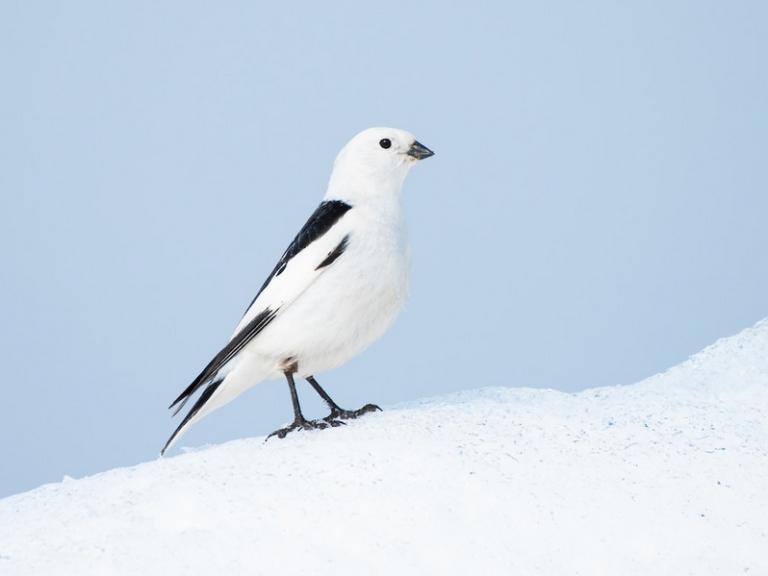Birdfinding.info ⇒ The most northerly breeding songbird is very common on its remote arctic breeding grounds. In winter, it is locally common across a broad swath of southern Canada and the northern tier of the continental U.S. Less common and widespread in Europe, where the largest wintering concentrations occur on Iceland and along coasts of the North Sea and southern Baltic Sea. Apparently much more localized and less numerous in Asia, where the few known regular wintering grounds include Novosibirsk Oblast, northern Inner Mongolia, and the eastern coast of Hokkaido.
Snow Bunting
Plectrophenax nivalis
Circumpolar breeder in arctic and subarctic regions. Winters on barren plains, lakeshores, and seacoasts of the subarctic and cold temperate zones.

Approximate distribution of the Snow Bunting. © Xeno-Canto 2024
Breeding. Breeds on tundra and rocky montane and coastal habitats in upper latitudes of the Northern Hemisphere, including most, if not all, high arctic island groups north to Ellesmere Island, Greenland, Jan Mayen, Bear Island, Svalbard, Franz Josef Land, Novaya Zemlya, Severnaya Zemlya, and Wrangel Island.
In Europe, it breeds throughout Iceland, in most parts of Norway, in adjacent parts of Sweden and northern Finland, and very locally in the Scottish highlands. Eastward, it breeds across the arctic portions of the Russian Federation, mostly near the Arctic Ocean coastline and more locally in some interior mountains: e.g., the northern Urals. In the Russian Far East, it breeds along the Bering Sea coast and the northern coast of the Sea of Okhotsk, south locally to southern Kamchatka and the Commander Islands.
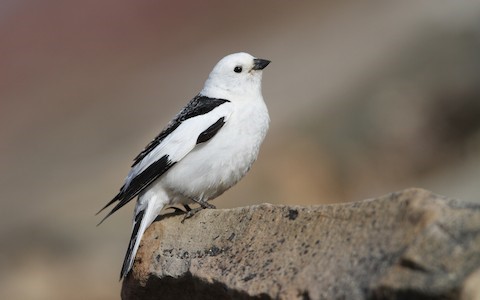
Snow Buntings breed farther north than any other songbird. (Longyearbyen, Svalbard; June 5, 2015.) © Christoph Moning
In North America, it breeds essentially throughout the arctic regions of Alaska and Canada, mainly near coasts, in mountains, and locally in other rocky areas. In Alaska, it breeds along the Bering Sea coast and islands—but not regularly on St. Matthew and Islands, where McKay’s Bunting replaces it—south to the Aleutians and Alaska Peninsula; and in all the major mountain ranges south to Kodiak Island, the Kenai Peninsula, and the Wrangell and St. Elias ranges. Also breeds in mountainous areas throughout the Yukon Territory and into northwestern British Columbia. Eastward in Canada, it breeds south to southern Keewatin, the Belcher Islands, Ungava Bay, and the mountains of northern Labrador.
Nonbreeding. Winters along coasts of the North Atlantic and North Pacific, and across broad interior swathes of Eurasia and North America. In winter, it can be found in all sorts of barren habitats, including coastal dunes, lakeshores, sparse grasslands, and stubble fields.
In western and northern Europe, it winters on Iceland, the British Isles, and coastally from the southern Baltic Sea south to Portugal. In the interior, it winters from Germany, Poland, and the Baltic nations south to Bulgaria and Ukraine, and eastward sparsely across the steppes of southern Russia, Kazakhstan, Mongolia, and northern Inner Mongolia—apparently rare in most of its Asian wintering range. In the Far East, it winters sparsely along coasts from the Chukchi Peninsula south to Hokkaido.
In northwestern North America, it winters along coasts from Kotzebue south to the Aleutians, east through south-coastal Alaska, and sparsely south to Oregon. In the interior, it winters from central Alaska and the Yukon Territory east across subarctic regions of Canada and south to the central latitudes of the continental U.S.: to northern Utah, Colorado, Kansas, and the Ohio Valley. Along the Atlantic Coast of North America, it winters from southeastern Labrador south to the Outer Banks of North Carolina.
In western and northern Europe, it winters on Iceland, the British Isles, and coastally from the southern Baltic Sea south to Portugal. In the interior, it winters from Germany, Poland, and the Baltic nations south to Bulgaria and Ukraine, and eastward sparsely across the steppes of southern Russia, Kazakhstan, Mongolia, and northern Inner Mongolia—apparently rare in most of its Asian wintering range. In the Far East, it winters sparsely along coasts from the Chukchi Peninsula south to Hokkaido.
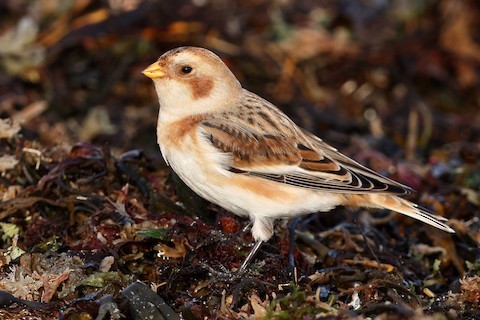
Many Snow Buntings winter along seacoasts. (Eastern Point, Gloucester, Massachusetts; November 17, 2023.) © Sam Zhang
In northwestern North America, it winters along coasts from Kotzebue south to the Aleutians, east through south-coastal Alaska, and sparsely south to Oregon. In the interior, it winters from central Alaska and the Yukon Territory east across subarctic regions of Canada and south to the central latitudes of the continental U.S.: to northern Utah, Colorado, Kansas, and the Ohio Valley. Along the Atlantic Coast of North America, it winters from southeastern Labrador south to the Outer Banks of North Carolina.
Movements. Southbound migrants typically arrive in wintering areas sometime between late October and early December, and depart in late February or March.
Vagrants regularly stray south of the normal wintering range as far as the Azores, Madeira, northern Mediterranean coasts and islands, South Korea, Honshu, central California, Tennessee, and Georgia.
More exceptional vagrants have been recorded south to the Canary Islands, southwestern Türkiye, Israel, Azerbaijan, the Yaeyama Islands (southwesternmost Japan), Hawaii, Midway Island, San Diego, southeastern Arizona, South Padre Island, and the central Bahamas.
Identification
Distinctive: a relatively large, plump, mostly white seedeater of cold, northern regions. In winter, often recognized by its “toasted marshmallow” coloration.
Most readily confused with the closely related, possibly conspecific, highly localized McKay’s Bunting, which is distinguished by more extensively white upperparts, wings, and tail. (See detailed comparison below.)
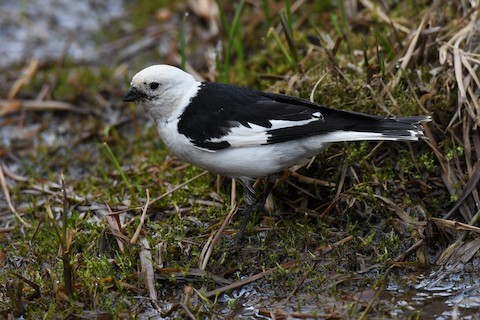
Snow Bunting, male in relatively dark breeding plumage. (Utqiaġvik, Alaska; June 28, 2022.) © Timothy Piranian
Male in breeding plumage is crisply attired in black and white. The head and underparts are all-white, with a contrasting black bill and eye. The upperparts, wings, and tail have patches of white and black.
The wings are mostly white with black shoulder-patches and all-black primaries. The central tail feathers and adjacent uppertail coverts are black; the outer tail feathers and rump are white.
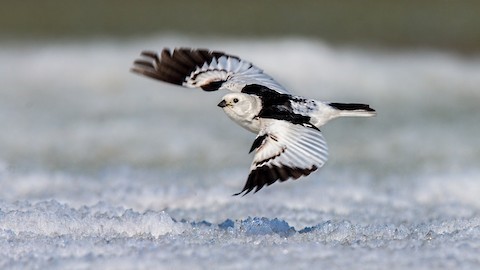
Snow Bunting, male in breeding plumage. (Cake Eater Road, Utqiaġvik, Alaska; June 15, 2017.) © Eric Gofreed
Most distinctively, the mantle and upper back are typically all-black, or sometimes black with whitish edges on the feathers, giving it a streaked appearance.
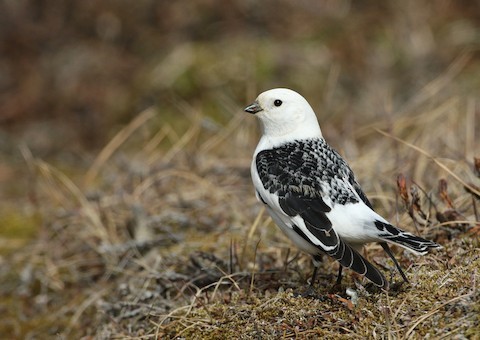
Snow Bunting, male in pale breeding plumage, showing streaks on the back. (Longyearbyen, Svalbard; May 27, 2018.) © Luke Seitz
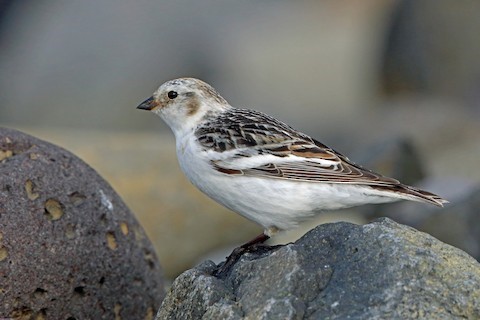
Snow Bunting, female in breeding plumage. (St. Paul Island, Alaska; May 25, 2015.) © Nigel Voaden
Female in breeding plumage resembles the male, but with some brown and gray mixed into the white and black of the upperparts, head, wings, and tail.
Males and females in nonbreeding plumage resemble breeding females but have yellow bills and variable rusty or orangish markings on the head, chest, and flanks—the visual impression of these markings is often compared to a toasted marshmallow.

Snow Bunting in pale nonbreeding plumage. (Hartford, Ohio; February 18, 2021.) © Brad Imhoff
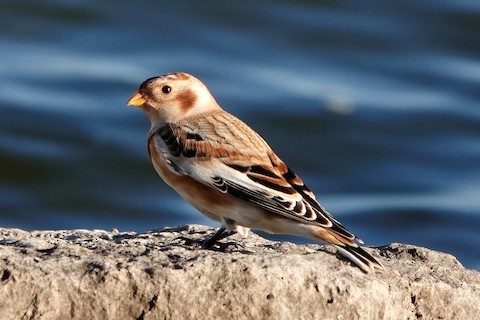
Snow Bunting in darker nonbreeding plumage. (Governor Nelson State Park, Westport, Wisconsin; October 30, 2021.) © Melissa Kesling
Nonbreeding males may be paler overall than nonbreeding females, but their patterns and coloration apparently overlap, so they are not usually distinguishable.
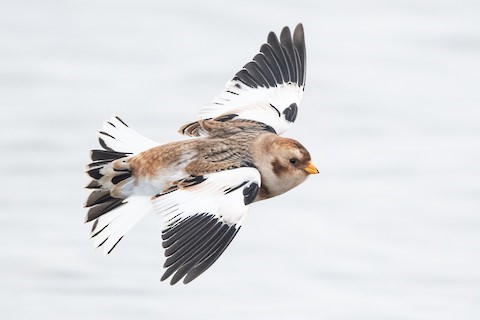
Snow Bunting in nonbreeding plumage. (Pointe de la Croix, La Haute-Côte-Nord, Quebec; November 18, 2022.) © David Turgeon
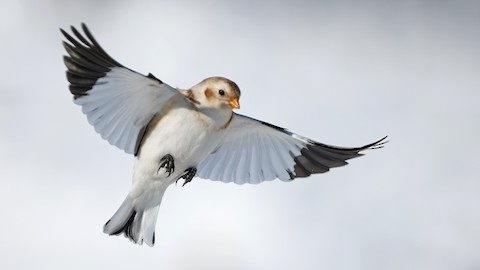
Snow Bunting in nonbreeding plumage. (Baie-du-Febvre, Nicolet-Yamaska, Quebec; January 21, 2022.) © Daniel Jauvin
First-winter birds can appear mostly brown-and-black, with white essentially limited to the secondaries and outer tail feathers.
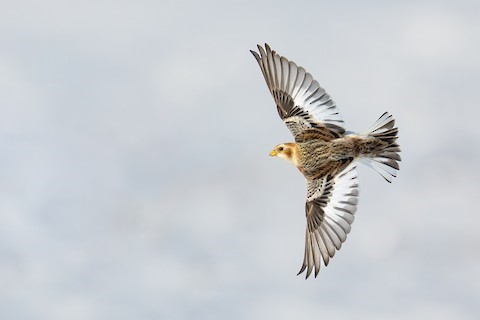
Snow Bunting in nonbreeding plumage, showing mostly brown streaked upperparts with limited white patches in secondaries and outer tail feathers. (Indianapolis Regional Airport, Indiana; February 5, 2022.) © Ryan Sanderson
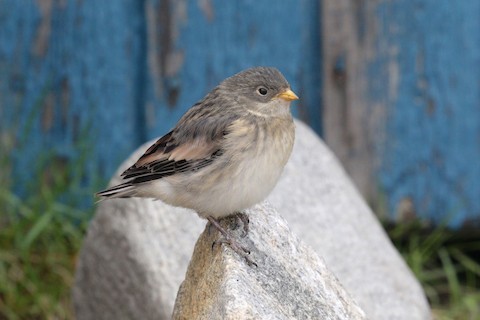
Snow Bunting, juvenile. (Nuuk, Greenland; July 9, 2022.) © Noah Strycker
Juveniles are mostly gray overall, usually darkest around the face. The back and wings are more brownish and streaked blackish.
Notes
Polytypic species consisting of four recognized subspecies. Sometimes regarded as conspecific with McKay’s Bunting (hyperboreus), which effectively replaces the Snow Bunting as a breeder on St. Matthew and Hall Islands in the northern Bering Sea.
After conducting a thorough analysis of plumage variation among McKay’s and Snow Bunting specimens collected in western Alaska, Withrow (2020) concluded that McKay’s is most appropriately classified as a subspecies of Snow. That conclusion was explicitly informed at least in part by the premise that McKay’s and Snow Buntings are allopatric. However, the tiny breeding range of McKay’s falls entirely within Snow’s enormous breeding range, and they have been known to occur together and hybridize at least occasionally both on St. Matthew and on islands where the Snow Bunting predominates, so it may be more accurate to regard them as effectively sympatric breeders. The persistence of McKay’s as a readily distinguishable form without substantial geographical isolation weighs in favor of full species status.
See below for a comparison of the Snow Bunting with McKay’s Bunting.
Cf. McKay’s Bunting. McKay’s Bunting may be regarded as either a separate species or a distinctive, highly localized form of Snow Bunting. They occur together year-round throughout McKay’s’ very limited range, which comprises a just few islands and coasts of the Bering Sea. McKay’s has been found several times in winter outside of its normal range, from south-coastal Alaska south to Oregon and once in summer along the northern coast of the Yukon Territory.

McKay’s Bunting, male in transition into breeding plumage. (Icy View, Nome, Alaska; March 27, 2022.) © Scott Page

Snow Bunting, male in typical breeding plumage, with a solid-black back. (Utqiaġvik, Alaska; June 28, 2022.) © Timothy Piranian
As a general rule, McKay’s Buntings in all plumages have more white feathering and less black feathering than Snow Buntings in the equivalent plumage, but the differences are not always clear-cut. Some individuals in some plumages may not be identifiable—and hybrids have been known to occur. Nevertheless, male McKay’s are readily identifiable year-round based on the coloration of their backs and the patterns on their wings and tails.
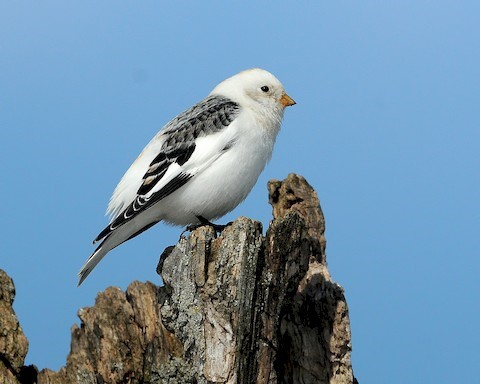
Snow Bunting, an exceptionally pale male in transition into breeding plumage—if it had been photographed in or near Alaska, this individual would likely be identified as a female McKay’s Bunting. (Whitby, Ontario; March 2, 2014.) © Ed McAskill
Back Coloration: In breeding plumage, male McKay’s has all-white body feathers above and below, whereas male Snow has an extensively black back. In winter, male Snow Buntings’ backs change from black to a streaky blend of black and rusty-brown. Nonbreeding male McKay’s often show some subtle streaking on the back, but remain much whiter above than any Snow Bunting.
Wing Pattern: Male McKay’s has a small and variable amount of black on the wings, usually confined to the tips of the primaries, and often a few black streaks or spots on the scapulars and alula (wrist). Male Snow Buntings usually have entirely black primaries and alula, and all-black scapulars in breeding plumage. In their nonbreeding plumage, the scapulars match the back coloration. However, they vary widely in the extent of black in their wings, with the palest male Snows showing essentially the same pattern as the darkest male McKay’s.

Snow Bunting in nonbreeding plumage showing extensive black on the wings and tail. (Pointe de la Croix, La Haute-Côte-Nord, Quebec; November 18, 2022.) © David Turgeon
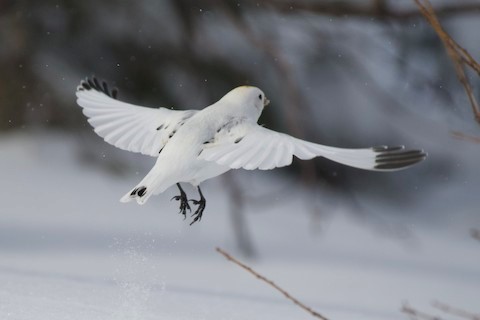
McKay’s Bunting, male showing limited black spots on the tail. (Icy View, Nome, Alaska; March 23, 2023.) © Josiah Verbrugge
Tail Pattern: There is little, if any, overlap in their tail patterns. On male Snow Buntings the six central tail feathers (i.e., three on each side) are entirely black, and the outer tail feathers typically have black outer webs near the tip. Male McKay’s typically show very little black on their tails, usually limited to the tips of the central tail feathers.
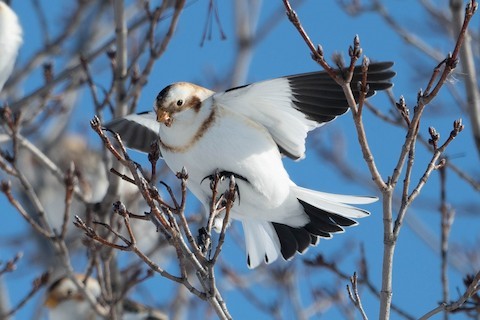
Snow Bunting in nonbreeding plumage, showing black primaries and central tail feathers. (Ottawa, Ontario; January 27, 2021.) © Ken & Fay Broten

McKay’s Bunting, male showing black wingtips and almost entirely white tail feathers. (Icy View, Nome, Alaska; February 18, 2017.) © Julio Mulero
Female McKay’s and Snow are somewhat more similar than the males, and may not be distinguishable in some cases. The key differences are: (1) the extent of white in the rump area; (2) the breadth of the white streaks on the back; (3) the presence or absence of dark streaks on the outer webs of the three outer tail feathers; and (4) the extent of white on the inner primaries and outer secondaries. In all of these features, female McKay’s typically has more white and less black than female Snow. However, judging from the comparisons of specimens presented by Withrow (2020), there appears to be at least marginal overlap in each of these features, such that the darkest female McKay’s and palest female Snow would be effectively identical.

McKay’s Bunting, female in breeding plumage, showing streaked back, white rump, and all-back central tail feathers. (St. Matthew Island, Alaska; June 28, 2018.) © Bryce Robinson

Snow Bunting, female in typical breeding plumage. (St. Paul Island, Alaska; May 25, 2015.) © Nigel Voaden
In their nonbreeding and transitional plumages, female McKay’s and both sexes of Snow Bunting can be much more difficult to distinguish. All have variably streaked backs orangish or rusty-brown markings on the head.

McKay’s Bunting in nonbreeding plumage—apparently a relatively dark male based on the absence of visible black in the tail. (Icy View, Nome, Alaska; December 8, 2016.) © Andrew Spencer

Snow Bunting in typical nonbreeding plumage. (Caldeira Seca, Morro Alto Natural Forest Reserve, Flores, Azores, Portugal; October 22, 2023.) © Jean-Louis Carlo
Many nonbreeding Snow Buntings have heavily streaked upperparts, including the rump, and extensive markings on the head and chest, sometimes extending down to the flanks. But many have all-white rumps, faintly streaked backs, and mostly white heads and chests. The palest nonbreeding Snow Buntings may be indistinguishable from female McKay’s.
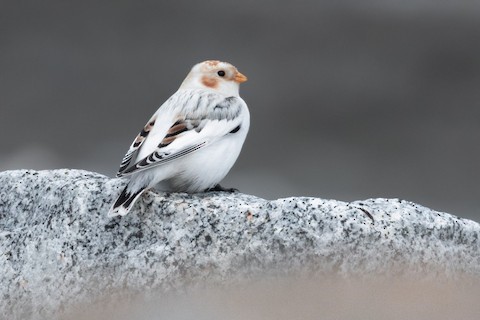
McKay’s Bunting, female in nonbreeding plumage. (Tsawwassen Ferry Terminal Jetty, Delta, British Columbia; December 8, 2019.) © Liron Gertsman

Snow Bunting in transition into nonbreeding plumage. (Crooked River Wetlands Complex, Oregon; November 13, 2023.) © Tom Crabtree
More Images of the Snow Bunting
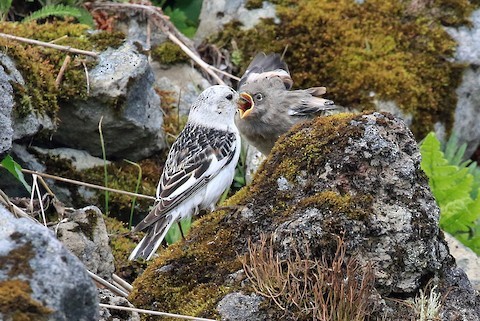
Snow Bunting, female in breeding plumage, feeding hatchling. (St. Paul Island, Alaska; June 18, 2016.) © Phillip Edwards

Snow Bunting in nonbreeding plumage—exceptionally rich rusty-orange. (Montrose Point Bird Sanctuary, Lincoln Park, Chicago, Illinois; November 12, 2022.) © Matt Zuro
References
Alderfer, J., and J.L. Dunn. 2021. National Geographic Complete Birds of North America (Third Edition). National Geographic Society, Washington, D.C.
BirdLife International. 2016. Plectrophenax nivalis. The IUCN Red List of Threatened Species 2016: e.T22721043A89345729. https://dx.doi.org/10.2305/IUCN.UK.2016-3.RLTS.T22721043A89345729.en. (Accessed January 28, 2024.)
Brazil, M. 2009. Birds of East Asia. Princeton University Press.
eBird. 2024. eBird: An online database of bird distribution and abundance. Cornell Lab of Ornithology, Ithaca, N.Y. http://www.ebird.org. (Accessed January 28, 2024.)
Garcia-del-Rey, E. 2011. Field Guide to the Birds of Macaronesia: Azores, Madeira, Canary Islands, Cape Verde. Lynx Editions, Barcelona.
Garcia-del-Rey, E. 2018. Birds of the Canary Islands. Christopher Helm, London.
Johnson, S.R., and D.R. Herter. 1989. The Birds of the Beaufort Sea. BP Exploration (Alaska) Inc., Anchorage, Alaska.
Kirwan, G.M., A. Levesque, M. Oberle, and C.J. Sharpe. 2019. Birds of the West Indies. Lynx Edicions, Barcelona.
Pyle, R.L., and P. Pyle. 2017. The Birds of the Hawaiian Islands: Occurrence, History, Distribution, and Status. Version 2 (January 1, 2017). http://hbs.bishopmuseum.org/birds/rlp-monograph/. B.P. Bishop Museum, Honolulu, Hawaii.
Salt, W.R., and J.R. Salt. 1976. The Birds of Alberta. Hurtig Publishers, Edmonton, Alberta.
Sibley, D.A. 2014. The Sibley Guide to Birds (Second Edition). Alfred A. Knopf. New York.
Svensson, L., K. Mullarney, and D. Zetterström. 2009. Birds of Europe (Second Edition). Princeton University Press.
Withrow, J. 2020, Plumage Variation in Bering Sea Plectrophenax Buntings and the Specific Status of McKay’s Bunting. Western Birds 51:174-189.
Xeno-Canto. 2024. Snow Bunting – Plectrophenax nivalis. https://xeno-canto.org/species/Plectrophenax-nivalis. (Accessed January 28, 2024.)
